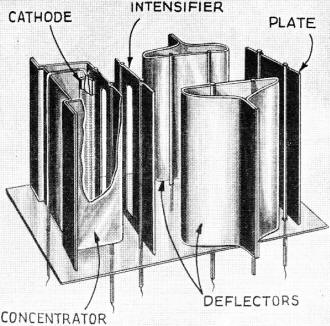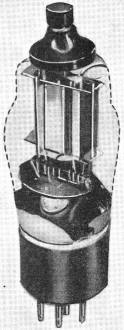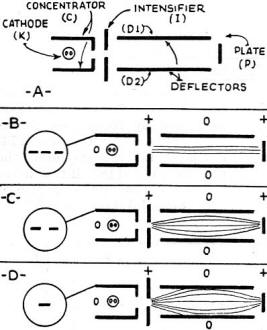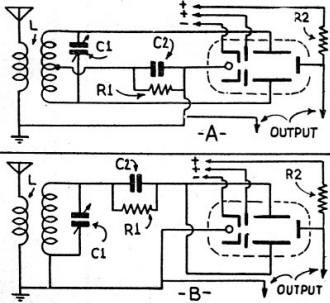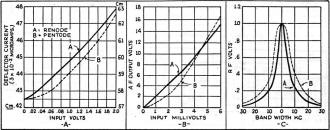The Renode - A New Gridless Tube
|
|
Competition amongst countries and businesses existed long before the advent of radio receivers. Here is an interesting story which demonstrates how international politics and corporate policies has been part of the electronics industry since its inception. In order to circumvent what were considered to be outlandish patent licensing fees, Danish engineer Carl Arne Scheimann Jensen developed a new "gridless" type of vacuum tube (aka valve) which was called the "Renode." Rather than using a screen grid in the path between the cathode and plate, the Renode employed two sets of beam concentrator and deflector plates on either side of the electron beam's path to modulate the conduction. According to measurements it provided a slight improvement in both linearity and selectivity. The article's author hints at the possibility that further manipulations and back-room deals might eventually scuttle the effort to bring Renodes to the mass market; given that even finding information on the Renode is nearly impossible at this time, evidently he was correct. The Renode - A New Gridless Tube Fig. A - The internal structure of the tube showing the cathode surrounded by a shield having a slot cut parallel to its axis; an "intensifier" to speed up the electrons; two "deflectors" to control the electron stream; and a plate. A revolutionary Danish radio receiving tube of "cathode-ray" type is announced in this exclusive story by our Danish correspondent. By Svend Anker-Rasmussen First Published Description! In this exclusive article Radio-Craft presents the first description in America of the radically new cathode-ray type of detector, amplifier and oscillator tube. According to available data it apparently results in more selective, sensitive, and noiseless performance than present grid-type tubes! It appears to rank in importance with the recently-announced (Jan. 1936 issue) Zworykin electron-multiplier "ray"-type tube. Gridless vacuum tubes, in a new series, have just been introduced in Denmark! Due to a peculiar patent set-up, Denmark has been subjected to excessive licensing fees, and it is this situation which the new tubes have been designed to circumvent. The following technical and political explanation outlines the characteristics and conditions under which the Renode, as the new tube is called, has been introduced. Operates on Cathode-Ray Principle In principle, the Renode has some resemblance to the Braun tube, the workings of the former being founded upon deflection of cathode rays (first utilized in the latter). The interior arrangement of the electrodes in the Renode is shown in Fig. 1A. The circle indicates a cross-section view of heater; and cathode, K. Element C is a metal screen or shield (hereinafter called the concentrator); it surrounds the cathode, and has a slit across it parallel with the length of the filament. Electrode I is an auxiliary plate termed the intensifier; it is plate-shaped and has in the middle of it a slot of exactly the same size and position as the one in the cathode screen. Plates D1 and D2 are called deflectors. The ordinary plate or "anode" is identified as P. Now let us proceed to see how this arrangement works, by referring to Fig. 1B. Potentials are applied to the electrodes as shown; cathode, and deflecting electrodes D1 and 2 are at zero voltage; the intensifier, I, and ordinary plate, P, under a certain positive potential; and the concentrator, C, at a suitable negative potential (as indicated by [- - -]). Under such conditions a concentrated, straight-line electron beam, the outlines of which are defined by the apertures of the concentrator and intensifier electrodes, will flow across to plate. Controlling the Beam Now, if the numerical value of the concentrator potential is decreased (as indicated by [ - - ], in Fig. 1C), the beam will spread itself out in the middle between the deflectors. A further decrease of the concentrator potential ( - ], in Fig. 1D) will result in some of the electrons touching the deflectors, which are thus compelled to receive a certain number of electrons. When the value of concentrator potential required to bring the tube functions into the state illustrated at Fig. 1D is found, the goal of "ordering the cathode ray" to suit a purpose has been reached. If R.F. currents are now applied to the deflectors, as shown in Fig. 2A, the beam will be deflected alternately towards either of the opposite deflector electrodes, which must again absorb a certain number of electrons varying according to the deflection. As the beam is "ordered" so that a very insignificant number of electrons are caught by the deflectors when these are at zero potentials, an increase of the total number of electrons caught by the deflectors will practically always result when an R.F. current is applied. The momentary number caught is a function of the rise and fall (fluctuation) of the R.F. voltage, and condenser C2 will be charged to a value depending on the momentary value of the controlling voltage; i.e., the voltage of condenser C2 will vary according to the modulations of the incoming R.F. voltage. Besides the R.F. controlling voltages we thus get impressed on the deflectors a negative potential that numerically varies with the R.F. modulation. creating in the space between the deflectors a negative electric field that counteracts the positive field from the intensifier, and thus permits less electrons to get through to the plate. Obtaining Detection Fig. 1- The tube action in detail. Fig. 2 - The circuit for detector action. Fig. 3. Comparative characteristics of Renode and Pentode as a detector. The plate current therefore will vary with the R.F. modulation; i.e., an increase of the applied R.F. voltage will result in a decrease of the plate current (or detection). Since in this arrangement the R.F. voltages on the deflectors at any time will be numerically equal but of opposite polarity, it is obvious that none of the R.F. oscillations in the input circuit will be carried over to the plate or intensifier (auxiliary plate) circuits. In plainer language: we get rid of those annoying tendencies to instability in the following A.F. stages, so familiar with conventional grid-controlled tubes. The situation is different if we hook the Renode up in a circuit like that illustrated by Fig. 2B. In this case the R.F. voltages applied to the deflectors are both equal in value and polarity, which condition naturally sets up R.F. currents in the plate and intensifier circuits, varying in concert with the incoming signals. In both diagrams the tube works as an "ordered beam"; however, in hookup A the beam moves brush-like, alternately towards either deflector plate, while in hookup B the beam "swells" in the middle, so to speak, and widens out towards the plates, as depicted in Fig. 1. Characteristic Curves With a view to further elucidating the behavior of the Renode a few characteristic curves drawn by the inventor on the basis of laboratory experiments are shown. Figure 3A shows the detector characteristic of the Renode (A) as compared with an ordinary R.F. pentode (B). The grid leak in both cases was 2 megs. (The readings on the vertical axis, left, are for the Renode, those to the right for the pentode; the units are in centimeters - i.e. readings on a large scale by means of a mirror-galvanometer - and they indicate relative values of deflector-currents plotted against input R.F. voltages at zero per cent modulation. To convert centimeters to inches, multiply the former by 0.3937.) Figure 3B shows the total amplification of a Renode (A) as compared with that of an R.F. pentode (B). Input voltage (abscissa) in millivolts at 30 per cent modulation is plotted against output in volts. In Fig. 3C, is shown the selectivity curve for a Renode (A) and a pentode (B) working in identical tuning circuits. For the sake of clarity both curves are reduced to a peak of 1 V., but actually the Renode curve had its peak at 4.6 V., while the pentode reached only 3.75 V. The two dotted lines denote values of voltage obtained at a band width of 10 kc. For the pentode we find a voltage of 0.77-V. but the Renode yields 0.47-V. or 61 per cent less than that of the pentode. This spells: better selectivity. The Patent Situation A peculiar condition surrounds the development of the Renode, as explained below. Initial experiments on the Renode were started some 5 years ago by A. Schleimann Jensen, a Danish engineer and radio editor. When, after 2 years, the fruits of his efforts were brought to the attention of the Radio Board of the Danish Post Office, which controls broadcasting in Denmark, the Radio Board secretly granted him a large sum to support further work. Some weeks ago he concluded his experiments and placed before an audience of experts (led by the chief engineer of broadcasting) - the Renode tube. The Renode timed its appearance on the market at a psychological hour when the whole Scandinavian (Denmark, Norway, Sweden, and even Germany) radio industry is combining in a fight against the international tube and patent trusts. In addition to the high prices for tubes (an American 50¢ tube sells in Denmark as a result of trust manipulations, for about $5.00!), of which about 1/2 million are imported annually, the national receiver-production in Denmark has been liable to payment of considerable royalties to holders of certain vital patents. It is utterly impossible to build a modern tube set legally unless sanctioned by the Dansk Radio Union (comprising 38 companies manufacturing radio equipment in Denmark), which, until now, has had complete control of set production. Now, however, with the advent of the Renode, four of the larger manufacturers have withdrawn from the Union, and are pinning their faith on the new tube! The Norwegians are in much the same fix as the Danes, as far as tube prices and patent licenses are concerned. In addition, broadcasting is having a very tough time in Norway right now, since the mountainous country necessitates a large number of comparatively powerful broadcasting stations. But the building and expansion of such a network, to service only 175,000 listeners, who pay an aggregate license fee of about 3 1/2 million kroner annually, is very expensive. In an effort to acquire more revenue an attempt was made to increase the number of listeners by designing a very inexpensive radio set - a Norwegian edition of the German "Volksempfänger;" or All-Peoples Receiver. However, real production has been withheld simply because the broadcasters are openly afraid that the international tube and patent firms will hamper the practical development by taking their toll on tubes and patent licenses. We find in Sweden that the association of Swedish radio manufacturers is having a terrific battle with the tube firms, which are alleged to have attempted to exercise a regular dictatorship over the industry. So, if the international trusts do not succeed in buying the Danish Renode people out - and I, for one, am perfectly satisfied they will not give in - it should be obvious that the Renode spells war on all other tube firms.
Posted August 9, 2023 |
|

